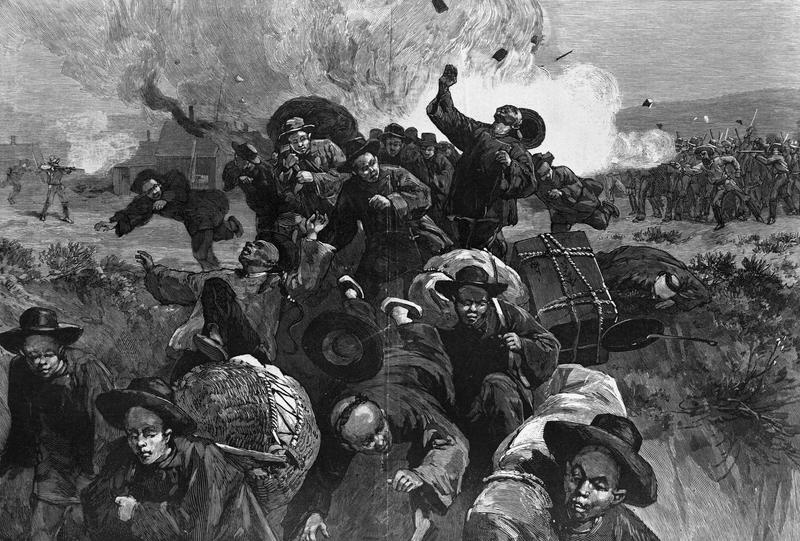The Rock Springs Massacre Of 1885: When 28 Chinese Miners Were Slaughtered, Homes Burned
By | April 2, 2021

Barely past the crack of dawn on September 2, 1885, an argument broke out between the Chinese and European immigrant workers of the Union Pacific Coal Company, and while it is difficult to know the exact sequence of events that took place in the mine that morning, two Chinese miners were beaten severely and one died. Rather than stopping or attempting to cover up the murder, the European miners actually marched out of the mine in protest of the presence of Chinese miners and traveled to the nearby town of Rock Springs, Wyoming, where they carried out one of the worst racially motivated massacres in U.S. history.

The context of the 19th-century American Western industrial climate is crucial to understanding this episode of violence. It is impossible to overstress just how important the completion of the transcontinental railroad was to the success of the United States as a nation, especially as the Industrial Revolution reshaped lifestyles and the economy across the globe. As a young nation, America saw western expansion as its destiny, but getting across safely was a long and often deadly task (just ask the Donner Party). The railroad was the country's only real hope of achieving that "sea to shining sea" dream. The Union Pacific connected the rail lines from Nebraska to Promontory Summit, Utah, where it met up with the Central Pacific Railroad, which would take you all the way to sunny California.
It was a dangerous job, and when the Central Pacific began hiring in January 1865, only a few hundred white men bothered to apply. Founder Charles Crocker turned to Chinese labor, which was plentiful at the time, as many had fled political unrest in China and continued migrating to America even as the Gold Rush of the 1850s died down. They faced perilous conditions, and many died, but they still fared better than their white counterparts, at least when it came to disease. The cultural tradition of making tea meant the water consumed by Chinese immigrants was boiled, killing off the parasites and bacteria that often lead to dysentery.

Even though long hours of backbreaking labor wasn't exactly the American dream these immigrants were chasing, anti-Chinese sentiment grew in the following years as many white Americans began to believe the migrants were taking jobs from citizens. Furthermore, European immigrants found it difficult to organize strikes and make an effective argument for higher wages if companies could usually find Chinese laborers willing to work for little. This exact scenario happened in Rock Springs in 1875, when white miners attempted to strike only to see over 100 Chinese workers brought in a couple of weeks later. In 1882, the U.S. government passed the Chinese Exclusion Act, which remains to this day the only time the United States has banned people of a specific nationality or ethnicity from entering the country.
Tensions were therefore already high when, once again, European laborers attempted to strike Union Pacific in the early 1880s. Many white miners formed a "Whitemen's Town" in Rock Springs, where they joined the Knights of Labor, an international labor federation. They attempted to recruit Chinese laborers to their cause, but when they found out the white men expected them to strike if their demands weren't met, they politely declined. That didn't please the white miners, to say the least.

After the attack on the two Chinese miners on the morning of September 2, 1885, several white miners began making the rounds, rustling up others to join them. At least 150 men armed themselves and descended upon the Chinatown section of Rock Springs at approximately 2:00 P.M. A few men demanded the residents pack their bags and leave, promising them one hour before they resorted to violence, but within half an hour, gunshots began to ring through the streets as the massacre began.
Many attempted to flee, only to be met by the mob, who almost completely surrounded the area and had begun violently robbing every resident of Chinatown, either beating them with the butts of their rifles or shooting them outright. Around 3:30 P.M., a group of white women also gathered at the edge of Chinatown and began firing their own shots into the homes and toward those fleeing. Fires were set, and in the end, all but one house was burned to ashes. Many in Chinatown died in the fires as they attempted to hide in their cellars, while others were shot, beaten, stabbed, and even scalped. In at least one instance, a man was mutilated and his genitalia was taken to a local saloon to be shown off as a "trophy of the hunt." Twenty-eight bodies were later recovered, but since many who fled were never accounted for and the city burned, historians estimate anywhere between 30 and 50 deaths in Chinatown that day.
Although 22 men were arrested, the all-white grand jury refused to indict, claiming they couldn't find any witnesses. The men received cheers and a standing ovation upon their release, and the Rock Springs Massacre incited others to use force against Chinese communities across the West, most notably in Oregon and Washington State. The effects of the Chinese Exclusion Act weren't completely eliminated until the passage of the Immigration and Nationality Act of 1965.

